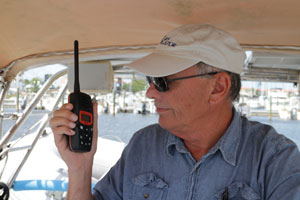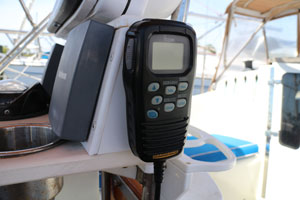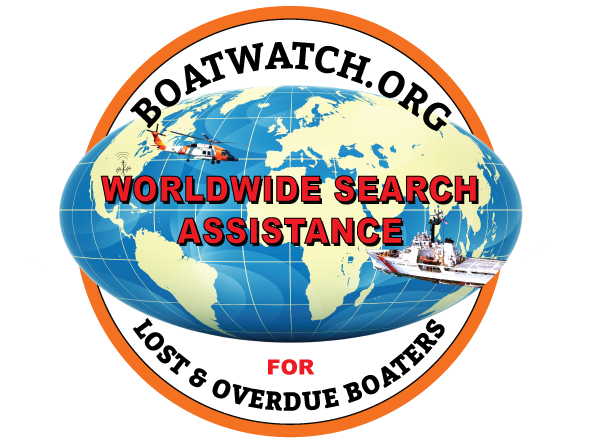The humble yet capable marine VHF
Voyagers may not be aware of all the capabilities of modern VHF radios
Although marine VHF radio has been around for a while, it has not only remained useful but is also still a vital part of any vessel’s safety equipment. In fact, VHF units are so capable that many cruisers may not even be aware of all the things they can do. And even with the advent of cellphones, VHFs are still important to any vessel’s communications system.
VHF-based communication came on to the boating scene around the same time FM receivers began showing in up cars back in the ‘60s. This makes sense, as they are both FM radios that have a clearer signal with less static and noise. The drawback to FM radios is that they have a limited range compared to that of the older AM radios. The limited range, however, is more than compensated for by a clear and easily understood signal that is critical in emergency communications.
The USCG does not recommend trying to use a cellphone in place of a VHF radio. In an emergency, a properly installed VHF will not only have a stronger signal but will reach more listeners as well. Being able to broadcast to many listeners at one time will result in faster response in an emergency; a cellphone simply cannot do that.
Like many of the electronic devices we use, VHF radios have improved over the years. Although their basic function remains the same, there have been many added safety features such as digital selective calling (DSC) and automatic identification system (AIS), as well as built-in GPS and the ability to communicate with other onboard electronics. All these new features add a new level of safety and automation to the humble VHF radio.
 |
|
Using a hand-held VHF radio at the helm. |
DSC is a standard for transmitting predefined digital messages and is a core part of the Global Maritime Distress Safety System (GMDSS). This is perhaps the most important safety improvement to VHF radio. What this means is that a VHF radio can now send a digital message to other VHFs and shore stations in an emergency. All new VHFs and many older units have a distress button to use in an emergency. When this button is pressed and held for five seconds, it will send a distress signal to the USCG and other vessels nearby, giving the transmitting vessel’s identification and position. Doing this allows the vessel operator to focus on dealing with whatever emergency is happening, freeing them from having to remain at the radio waiting for a response from potential rescuers. Additionally, it relieves them from having to relay position information, and helps avoid problems with inaccurate or misunderstood information. This is particularly important in the event of a fire or flooding — push the button and get to work saving the boat!
Setup is important
Emergency DSC is great, but it only works if it is properly set up. Many boaters fail to make sure their radios are prepared to take advantage of this system. The first thing that needs to be done when installing a VHF with emergency DSC is to make sure the MMSI number is programed into the memory. A Maritime Mobile Service Identity (MMSI) number is a nine-digit number unique to the vessel, not to the radio. This number is obtained from the FCC, but several organizations such as the U.S. Power Squadrons, Sea Tow and BoatUS have websites to help with the application process. If you plan to operate in international waters outside the U.S., you must get your MMSI number through the FCC. The USCG or other emergency services use this number to identify the vessel and its operators. This will help verify the distress call and speed rescue operations.
If you purchase a used boat, the number will have to be transferred into the new owner’s name. If purchasing a used radio, a new number will have to be programmed; however, most radios only allow the number to be changed once. If more changes are required, the radio may have to be taken to a dealer for reprogramming. If you are considering purchasing a used radio, be sure a new number can be programmed.
 |
|
An Icom wired remote. |
Along with the MMSI number, the radio should have GPS input for the DSC to be able to send the vessel’s position, an important requirement. All radios with DSC will either have an NMEA input for position from an outside GPS or have a built-in GPS. Most radios will alert the operator if there is no GPS input on startup.
Using the emergency DSC function is, by design, simple. The operator lifts the red safety cover, pressing and holding the button for five seconds, then activates the emergency transmission. The rest is automatic: A digital distress signal is sent on channel 70, leaving channel 16 free for emergency voice communications. This digital transmission is sent repeatedly every few minutes until a receiving station sends back a digital acknowledgment. Once an acknowledgment has been sent to the transmitting radio, both radios will automatically switch to channel 16 for voice contact. Most radios will also allow the operator to select from a preprogrammed list of emergency types prior to sending a distress signal. These preprogrammed types include flooding, fire, grounding and so on. If the operator does not have time to select from the list, an “undesignated” alert will be sent. I strongly suggest all operators take the time to familiarize themselves with how to send an emergency DSC signal. Check the operator’s manual for how to select the type of emergency, and practice without actually sending a distress.
Non-emergency DSC
DSC can also be used for non-emergencies as well. A list of MMSI numbers for other boats can be stored in the VHF so that quick contact can be made without having to call on channel 16. A DSC call request can be made with a working channel set; when the call is received by the other vessel and acknowledged, both radios change to the working channel selected and you are ready to talk. You can page a single vessel or a group of vessels. Many cruisers use this feature for contacting other boats they may be traveling with. DSC can also be used to ping or query another vessel for its GPS location — when the DSC request is sent and received, the other vessel returns its position. If you have a hand-held VHF with GPS and DSC, these features can be great for keeping up with shore parties or with crew out exploring in the dinghy.
 |
|
An Icom VHF installed at a nav station. |
Another feature now being offered on many VHF radios is AIS. For those not familiar with this, it is an automated system that digitally transmits a vessel’s position, heading, speed and identification to other vessels in the area. This is done on a VHF channel, so it is natural to see this built into the vessel’s main VHF radio. For commercial vessels and larger yachts, a dedicated transponder that both sends and receives AIS information is normally installed; for smaller vessels, receive-only is often used. Even if the vessel has a separate AIS transponder, this capability built into the main VHF is a nice backup. Most VHF radios with this feature will be receive-only, but some can both receive and transmit. Due to smaller displays on most VHF radios, it can be a bit hard to visualize where another vessel may be headed, but most units equipped with this feature can also send this data to a plotter via NMEA data.
Other features that could prove useful include voice scrambling, channel scanning, remote operation, hailer functions, weather alerts, active noise canceling, waterproofing and NMEA input/output. Voice scrambling is of limited use and more popular with fishermen not wanting to reveal their good fishing locations, but it also could be useful to cruisers wishing to discuss travel or shore plans without alerting local criminal factions.
Channel scanning, on the other hand, is a very useful feature. By law, any vessel with a VHF radio is required to monitor channel 16. Because channel 16 is the station most radios are set on, it is also used to contact other vessels and shore stations. This is normally not a problem, but the channel can get pretty busy at times with this non-emergency traffic. With all this chatter on 16, it is possible a true emergency could be overlooked. With channel scanning, a working channel can be used for contact as well as talking without blocking 16 or missing possible emergencies.
 |
|
An Icom unit with GPS input. |
There are a few scanning options built into many radios. Some allow scanning just a couple of channels, while others allow scanning all the channels. Many radios allow the user to customize the scanning to whatever stations that need to be monitored. For example, many commercial vessels and port operations will only communicate on channel 13, and many bridges operate on channel 9. Being able to hear what is happening on these — plus 16 at the same time — can add a level of safety, particularly when in crowed harbors.
Many VHF radios have the option of installing a remote control. This can be helpful for sailboats and flybridge cruisers, as it makes it easy to have a second control for the VHF close to the helm without having to install a whole new unit. It also keeps the main unit in the cabin away from weather and salt spray. Most remotes are hardwired, but some manufacturers are now offering wireless remotes.
Handheld developments
Most of the above referred to fixed-mount VHF radios, but handhelds have come of age as well. Hand-held VHF radios are great for taking in a dinghy or using while ashore to stay in touch with the mother ship. They are also handy to keep at the helm for short-range local communications, such as communicating with bridge tenders or marina dock personnel. They can also be useful for monitoring weather channels and marine alerts.
One of the biggest advances to hand-held units has been making them truly waterproof. This makes these devices safer to use outside in any weather, and it also makes them an important addition to the gear kept aboard a dinghy. Many units now float if dropped overboard, and some even have water-activated flashing displays or strobe lights should the unit go over the side at night.
 |
|
A Class B AIS transceiver. Unlike Class A units designed for commercial vessels, Class B devices have a lower reporting rate but can still pick up all Class A data. |
How you plan to use your handheld will dictate some of the options that you may desire. Handhelds vary in price from less than $100 to more than $250. On one hand, there is no point in paying for options that will never be used; on the other, the higher-priced units offer more flexibility.
Most of the higher-end handhelds now have built-in GPS and DSC. As mentioned earlier, this can be useful when used as a shore or dinghy communication device. Not only will this option help the mother ship keep track of those off on excursions, but it will also serve as a valuable safety item. Most small dinghies do not have much in the way of electronics, so a handheld with these safety features can make a big difference in an emergency. Keep in mind, though, that hand-held VHF radios do not have the same power and range as their fixed-mount cousins. Most hand-held units operate on one to five watts, compared to the 25 watts of a fixed station. Additionally, the height of the antenna has a big impact on how far the signal will go.
Battery life has improved with handhelds just as it has for many other types of portable electronics. Most units now have lithium-ion battery packs, with some offering an option to replace the battery pack with alkaline batteries. This could be helpful if a charging source is not available but spare alkaline batteries are. A good example of this would be for a handheld stored in a ditch bag. Alkaline batteries have a longer shelf life and do not self-discharge, meaning they can be stored for up to three years and still have 90 percent capacity.
Handheld battery life can range from five to 20 hours depending on the unit and its additional capabilities. A handheld operating its GPS will not get the same battery life as a simple unit in standby mode. Most manufacturers rate battery life based on a 5-5-90 rule. This means they assume the radio will transmit 5 percent of the time, actively receive 5 percent of the time, and be in standby mode the remaining 90 percent of the time. Handhelds have a transmit power of one watt on low power and five watts on high power. To increase battery life, most transmissions should be made on low power. Most handhelds are used for close-range work and will operate fine while transmitting on one watt.
 |
|
A DSC-equipped VHF radio that has not been programmed with an MMSI number will display a warning screen as a reminder. |
Recharging
The most convenient and easiest way to recharge a handheld is with a charging station. This is basically a plastic stand that charges the battery when the handheld is placed in it. Some units come with slow chargers, while others may offer a fast charger. A slow charger could take more than 10 hours to fully recharge a battery, while the fast chargers can take as little as two to three hours for a full charge. If you use a handheld frequently, the fast charger may be the way to go in order to reduce downtime.
Displays for handhelds have also improved, with larger displays offering more information in an easier-to-read layout. Other options that could be of interest include wired headsets or speaker microphones; removable antennas that allow you to connect the handheld to a fixed antenna, in case your main VHF fails; and the typical add-ons like belt clips and spare batteries.
VHF radios have come a long way since they first started being used on recreational boats. They offer a safety level that is still important, even with the advent of cellphones. The addition of DSC emergency calling has made them even more essential, provided that it is properly set up. Improvements continue to be made, making these humble little radios even more useful to our boating safety. Hand-held VHF radios bring this safety with you in a compact lightweight package that can be carried even in a small boat or dinghy. To take full advantage of all the new features, it helps to take the time to study the owner’s manuals and get to know all the “hidden” features you may not be taking advantage of.
Contributing editor Wayne Canning is a self-employed marine surveyor, delivery skipper and freelance boating writer.
